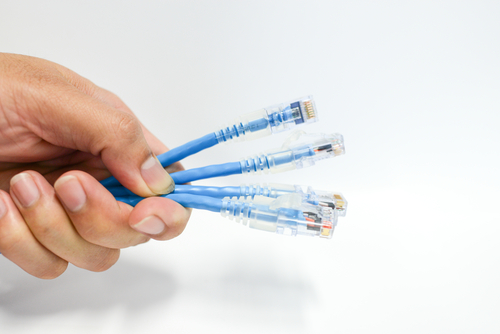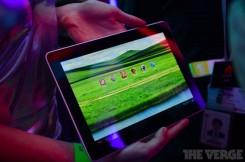 Under normal circumstances, a successful test of a 260-mile-long optical network link that tops 200 gigabits-per-second would be impressive. But on the cusp of changes in the design of large-scale corporate networks, a 200Gbit/sec long-haul connection looks a lot more like the corporate wide-area-network backbone of the future, according to a pair of recent market-research reports. Verizon Communications announced today it had finished a month-long test in which it had been able to run test data at 200Gbit/sec across an optical-networking link that was part of Verizon's existing production network, and which carried live customer traffic during the full period of the test. The link occupied a single wavelength within the existing fiber and used 16 quadrature amplitude modulation (16QAM) to double the number of bits a single wavelength could carry. If it turns out to be commercially viable, Verizon will likely use the 200Gbit/sec setup for high-speed links intended to keep pace with growth in LTE and 4G data traffic as well as increases in network use due to online video and cloud computing, according to a Verizon announcement. Ultra-high-speed backbones will become more important within corporate wide-area networks as well as those of carriers, as corporate networks are beefed up to allow wireless LANs at the network's edge to become the standard way for employees to get online, according to a market-research report released today from Dell'Oro Group. Sales of both wired and wireless LAN gear are increasingly combined into a single set of access points designed to support far more end users and devices than traditional "edge" networking products, the report suggested. Tablets, smartphones, laptops and other mobile devices have become so typical for knowledge workers that traditional, desktop-bound wired-Ethernet connections to a workgroup LAN (and from there to a campus switch) are becoming archaic, if not yet obsolete. "Enterprises are now emphasizing wireless LAN connectivity as a primary means of connecting workers to the corporation," Dell'Oro analyst Chris DePuy wrote in the announcement of the report. Sales of both wired and wireless LAN gear will continue to grow to keep pace with the expansion of beefier network edges, but switches at the network's edge will increasingly steal market share from campus-networking gear, the report added. Sales of WLAN gear designed for large corporations increased 16.8 percent between the fourth quarter of 2012 and first quarter of 2013, according to an ABI Research study released last week. Another $6 billion per year will go into virtualizing mobile networks alone—independent of any growth in SDN within other segments of the networking market, according to ABI. Data from all those WiFi, 3G, 4G, LTE and other mobile connections will have to funnel efficiently from the edge of the network to the network's core in the datacenter, to be munged into high-speed backbone connections between datacenters, corporate campus facilities or other concentrations of corporate end users, according to both the Dell'Oro and ABI reports. Verizon's 200Gbit/sec may not compare to the 2 terabits per second the GEANT pan-European research network can boast, let alone the 100Gbit/sec IP bandwidth and 8.8Tbit/sec optical-network capacity of the U.S. research network Internet2. By 2017, however, the majority of spending on corporate Ethernet networks will be for 40Gbit/sec and 100Gbit/sec hardware, according to Dell'Oro, with the emphasis shifting toward even higher-bandwidth connections as the network edge gets more crowded and the core has to beef up to keep up. Image: Itsaret Yannasit/Shutterstock.com
Under normal circumstances, a successful test of a 260-mile-long optical network link that tops 200 gigabits-per-second would be impressive. But on the cusp of changes in the design of large-scale corporate networks, a 200Gbit/sec long-haul connection looks a lot more like the corporate wide-area-network backbone of the future, according to a pair of recent market-research reports. Verizon Communications announced today it had finished a month-long test in which it had been able to run test data at 200Gbit/sec across an optical-networking link that was part of Verizon's existing production network, and which carried live customer traffic during the full period of the test. The link occupied a single wavelength within the existing fiber and used 16 quadrature amplitude modulation (16QAM) to double the number of bits a single wavelength could carry. If it turns out to be commercially viable, Verizon will likely use the 200Gbit/sec setup for high-speed links intended to keep pace with growth in LTE and 4G data traffic as well as increases in network use due to online video and cloud computing, according to a Verizon announcement. Ultra-high-speed backbones will become more important within corporate wide-area networks as well as those of carriers, as corporate networks are beefed up to allow wireless LANs at the network's edge to become the standard way for employees to get online, according to a market-research report released today from Dell'Oro Group. Sales of both wired and wireless LAN gear are increasingly combined into a single set of access points designed to support far more end users and devices than traditional "edge" networking products, the report suggested. Tablets, smartphones, laptops and other mobile devices have become so typical for knowledge workers that traditional, desktop-bound wired-Ethernet connections to a workgroup LAN (and from there to a campus switch) are becoming archaic, if not yet obsolete. "Enterprises are now emphasizing wireless LAN connectivity as a primary means of connecting workers to the corporation," Dell'Oro analyst Chris DePuy wrote in the announcement of the report. Sales of both wired and wireless LAN gear will continue to grow to keep pace with the expansion of beefier network edges, but switches at the network's edge will increasingly steal market share from campus-networking gear, the report added. Sales of WLAN gear designed for large corporations increased 16.8 percent between the fourth quarter of 2012 and first quarter of 2013, according to an ABI Research study released last week. Another $6 billion per year will go into virtualizing mobile networks alone—independent of any growth in SDN within other segments of the networking market, according to ABI. Data from all those WiFi, 3G, 4G, LTE and other mobile connections will have to funnel efficiently from the edge of the network to the network's core in the datacenter, to be munged into high-speed backbone connections between datacenters, corporate campus facilities or other concentrations of corporate end users, according to both the Dell'Oro and ABI reports. Verizon's 200Gbit/sec may not compare to the 2 terabits per second the GEANT pan-European research network can boast, let alone the 100Gbit/sec IP bandwidth and 8.8Tbit/sec optical-network capacity of the U.S. research network Internet2. By 2017, however, the majority of spending on corporate Ethernet networks will be for 40Gbit/sec and 100Gbit/sec hardware, according to Dell'Oro, with the emphasis shifting toward even higher-bandwidth connections as the network edge gets more crowded and the core has to beef up to keep up. Image: Itsaret Yannasit/Shutterstock.com Enterprise Networks Shift Toward Extremes at Edge and Core
 Under normal circumstances, a successful test of a 260-mile-long optical network link that tops 200 gigabits-per-second would be impressive. But on the cusp of changes in the design of large-scale corporate networks, a 200Gbit/sec long-haul connection looks a lot more like the corporate wide-area-network backbone of the future, according to a pair of recent market-research reports. Verizon Communications announced today it had finished a month-long test in which it had been able to run test data at 200Gbit/sec across an optical-networking link that was part of Verizon's existing production network, and which carried live customer traffic during the full period of the test. The link occupied a single wavelength within the existing fiber and used 16 quadrature amplitude modulation (16QAM) to double the number of bits a single wavelength could carry. If it turns out to be commercially viable, Verizon will likely use the 200Gbit/sec setup for high-speed links intended to keep pace with growth in LTE and 4G data traffic as well as increases in network use due to online video and cloud computing, according to a Verizon announcement. Ultra-high-speed backbones will become more important within corporate wide-area networks as well as those of carriers, as corporate networks are beefed up to allow wireless LANs at the network's edge to become the standard way for employees to get online, according to a market-research report released today from Dell'Oro Group. Sales of both wired and wireless LAN gear are increasingly combined into a single set of access points designed to support far more end users and devices than traditional "edge" networking products, the report suggested. Tablets, smartphones, laptops and other mobile devices have become so typical for knowledge workers that traditional, desktop-bound wired-Ethernet connections to a workgroup LAN (and from there to a campus switch) are becoming archaic, if not yet obsolete. "Enterprises are now emphasizing wireless LAN connectivity as a primary means of connecting workers to the corporation," Dell'Oro analyst Chris DePuy wrote in the announcement of the report. Sales of both wired and wireless LAN gear will continue to grow to keep pace with the expansion of beefier network edges, but switches at the network's edge will increasingly steal market share from campus-networking gear, the report added. Sales of WLAN gear designed for large corporations increased 16.8 percent between the fourth quarter of 2012 and first quarter of 2013, according to an ABI Research study released last week. Another $6 billion per year will go into virtualizing mobile networks alone—independent of any growth in SDN within other segments of the networking market, according to ABI. Data from all those WiFi, 3G, 4G, LTE and other mobile connections will have to funnel efficiently from the edge of the network to the network's core in the datacenter, to be munged into high-speed backbone connections between datacenters, corporate campus facilities or other concentrations of corporate end users, according to both the Dell'Oro and ABI reports. Verizon's 200Gbit/sec may not compare to the 2 terabits per second the GEANT pan-European research network can boast, let alone the 100Gbit/sec IP bandwidth and 8.8Tbit/sec optical-network capacity of the U.S. research network Internet2. By 2017, however, the majority of spending on corporate Ethernet networks will be for 40Gbit/sec and 100Gbit/sec hardware, according to Dell'Oro, with the emphasis shifting toward even higher-bandwidth connections as the network edge gets more crowded and the core has to beef up to keep up. Image: Itsaret Yannasit/Shutterstock.com
Under normal circumstances, a successful test of a 260-mile-long optical network link that tops 200 gigabits-per-second would be impressive. But on the cusp of changes in the design of large-scale corporate networks, a 200Gbit/sec long-haul connection looks a lot more like the corporate wide-area-network backbone of the future, according to a pair of recent market-research reports. Verizon Communications announced today it had finished a month-long test in which it had been able to run test data at 200Gbit/sec across an optical-networking link that was part of Verizon's existing production network, and which carried live customer traffic during the full period of the test. The link occupied a single wavelength within the existing fiber and used 16 quadrature amplitude modulation (16QAM) to double the number of bits a single wavelength could carry. If it turns out to be commercially viable, Verizon will likely use the 200Gbit/sec setup for high-speed links intended to keep pace with growth in LTE and 4G data traffic as well as increases in network use due to online video and cloud computing, according to a Verizon announcement. Ultra-high-speed backbones will become more important within corporate wide-area networks as well as those of carriers, as corporate networks are beefed up to allow wireless LANs at the network's edge to become the standard way for employees to get online, according to a market-research report released today from Dell'Oro Group. Sales of both wired and wireless LAN gear are increasingly combined into a single set of access points designed to support far more end users and devices than traditional "edge" networking products, the report suggested. Tablets, smartphones, laptops and other mobile devices have become so typical for knowledge workers that traditional, desktop-bound wired-Ethernet connections to a workgroup LAN (and from there to a campus switch) are becoming archaic, if not yet obsolete. "Enterprises are now emphasizing wireless LAN connectivity as a primary means of connecting workers to the corporation," Dell'Oro analyst Chris DePuy wrote in the announcement of the report. Sales of both wired and wireless LAN gear will continue to grow to keep pace with the expansion of beefier network edges, but switches at the network's edge will increasingly steal market share from campus-networking gear, the report added. Sales of WLAN gear designed for large corporations increased 16.8 percent between the fourth quarter of 2012 and first quarter of 2013, according to an ABI Research study released last week. Another $6 billion per year will go into virtualizing mobile networks alone—independent of any growth in SDN within other segments of the networking market, according to ABI. Data from all those WiFi, 3G, 4G, LTE and other mobile connections will have to funnel efficiently from the edge of the network to the network's core in the datacenter, to be munged into high-speed backbone connections between datacenters, corporate campus facilities or other concentrations of corporate end users, according to both the Dell'Oro and ABI reports. Verizon's 200Gbit/sec may not compare to the 2 terabits per second the GEANT pan-European research network can boast, let alone the 100Gbit/sec IP bandwidth and 8.8Tbit/sec optical-network capacity of the U.S. research network Internet2. By 2017, however, the majority of spending on corporate Ethernet networks will be for 40Gbit/sec and 100Gbit/sec hardware, according to Dell'Oro, with the emphasis shifting toward even higher-bandwidth connections as the network edge gets more crowded and the core has to beef up to keep up. Image: Itsaret Yannasit/Shutterstock.com 
